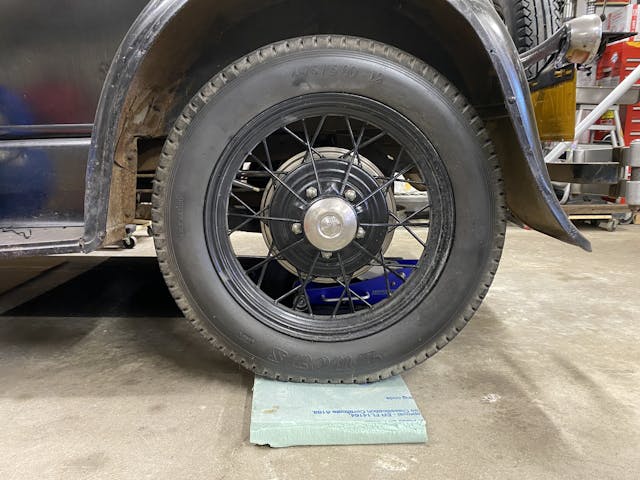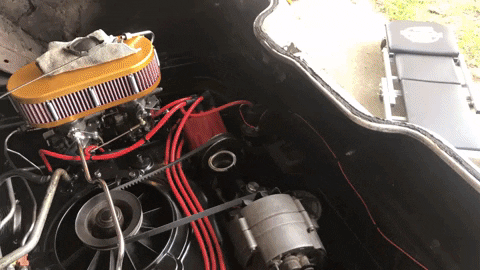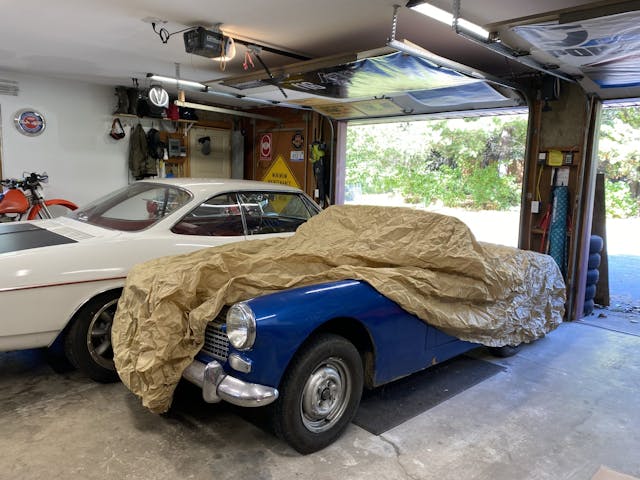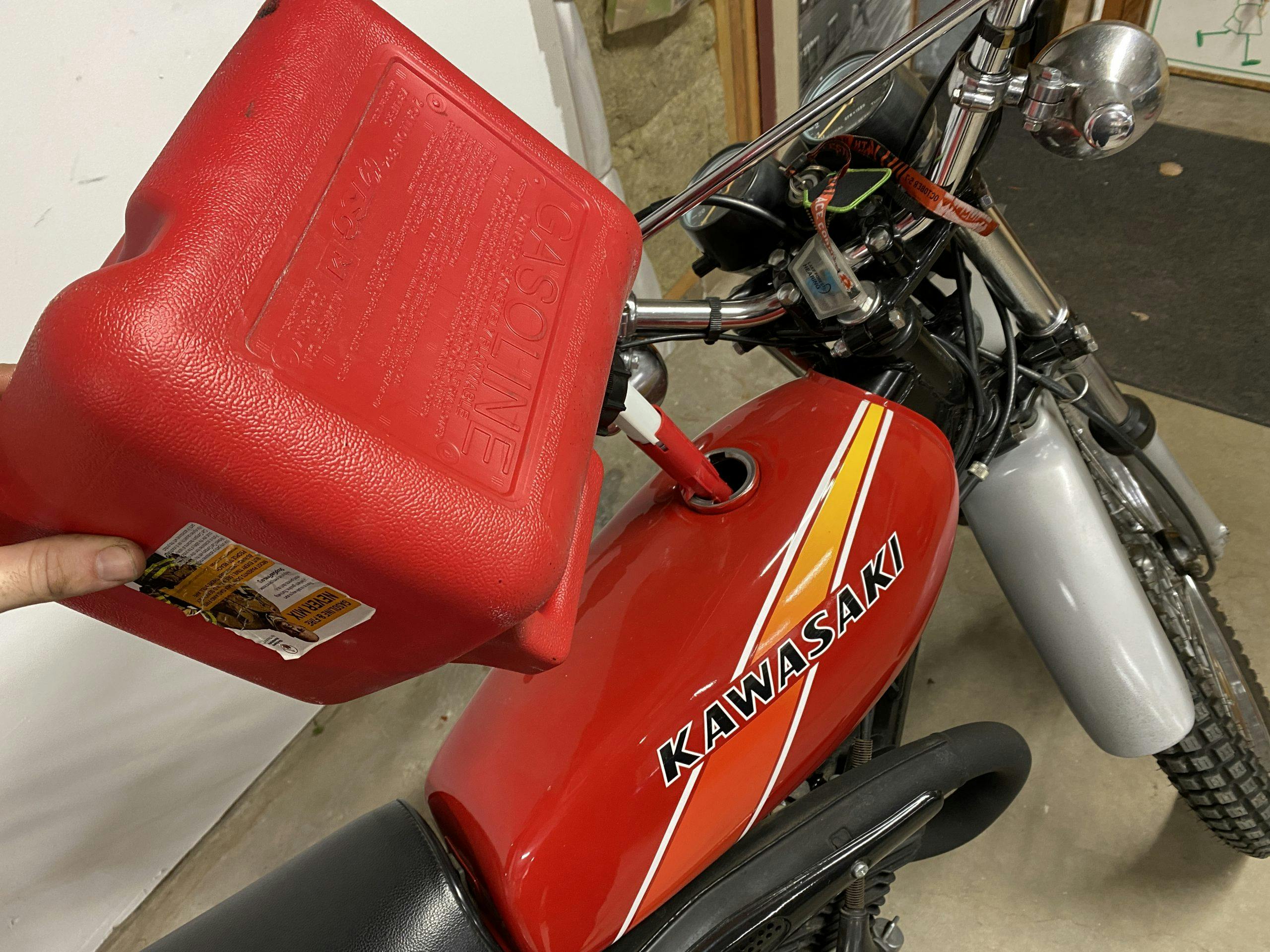4 critical steps for winter storage prep
Whether we like it or not, the changing of the seasons is upon us, and that means some of us are mentally preparing for the saddest day of the year—when we tuck our vintage toys into seasonal storage. It can be a rough day for a bunch of reasons, but a little stress and care right now can make for an extra delightful spring when you take your car out for that first drive.
Top up (two ways)
Storing with non-ethanol fuel is best, but not everyone has access to it, or it may come at enough of a premium that it’s not in the cards right now. Regardless of fuel type, fill the tank to the top and add an appropriate fuel stabilizer. Most vintage fuel tanks are steel and thus are very susceptible to rust, which can flake off and fill your fuel system with debris. Holy headache. With the tank topped off, there is no room for air and thus rust is kept at bay. Once you have some stabilizer in the tank, be sure to run the car for 10-15 minutes to make sure that it circulates through the entire fuel system.
The other “top” to think about is the convertible top. While you might never put the top for the summer, it is in your best interest to store a car with the top up so that it does not shrink or otherwise get damaged from long-term storage while being folded up. This is especially important for plastic rear windows that will lock into a shape when held in a particular way for too long. Replacing tops is not fun, and you aren’t driving anyway, so why not use it as the time to get your top back into shape?
Insulate your tires

Tires are made for driving, not for parking. That’s why long-term storage is likely to cause flat spots or dry-rotting of the rubber rings we need so dearly. There are appropriate products on the market that can help, but it’s also just as easy to pick up some insulation foam board and cut a few squares that fit under your tires. This will form a cradle for the tire and also keep the dirt or concrete under the car from sucking the moisture out of the rubber, making them last longer. If you want to go an extra step in moisture management, lay down a tarp or painter’s plastic sheet under the car to prevent the cool chassis from condensing any moisture that might rise up from the ground.
Cover up

If your storage spot has windows or is open on one side, be sure to utilize a good quality car cover. UV degradation can happen fast when a car is parked in one spot and the sunlight only hits a specific spot day after day. Your seats, paint, and trim will thank you for covering up, as it will also keep scratches and dust off your precious vintage ride. Speaking of dust, be sure that the car is clean before you cover it. Really clean. A cover can grind any dirt and debris left on the car into your delicate paint. Also, remember that covers don’t do much to protect from dents, so make sure your car does not become a shelf or leaning place for other things in the garage.
Fresh fluids

At a minimum, your car should get fresh oil and a coolant check. Oil traps combustion byproducts, and if left in the crankcase to sit all winter you can end up with corrosion or deposits that require serious work to remove. An oil change right before storage is cheap insurance. Coolant needs to be properly mixed for the temperatures the car will see in storage so it doesn’t freeze. Freezing liquids can exert tons of force—enough to literally split your engine block in two. You can be sure with a simple $3 tester, or if you’re really unsure and the coolant looks or smells dirty, a flush and fill could be your best option.
While under the hood looking at fluids, take a moment to inspect your brake fluid, as it can absorb moisture too. Flush with fresh fluid if the reservoir is anything but a nice light amber color.
Good luck. Spring will be here before you know it. (We hope.)





Step 1: Don’t… I try to keep mine up and running year round. If the roads are dry and salt-free, I’m riding
Yeah, but “dry and salt-free” are big “ifs” where I live.
AGREE!
Arazona
Concrete garage floors should be sealed with a two-part epoxy finish that is available at home centres and hardware stores. It prevents moisture from coming through the porous concrete, and makes a very tough, clean dust-free surface that is easy to clean spills from.
Batteries should be removed from the car during any length of storage. I have had two of the much fabled Optima red top batteries leak acid from the vents and terminals. It’s just not worth the risk of damaging your prized car.
Store the car with the windows rolled down about 1/4″, the doors, hood, convertible top and trunk unlatched, and newspaper between the windshield wipers and the windshield. This will protect the seals from long periods of compression, and allow a little more air circulation.
Leave the manual transmission in neutral and the parking brake disengaged. Use rubber wheel chocks to prevent the car from rolling in either direction.
Inflate tires to 10psi less than the maximum allowed pressure. For example, if the sidewalk specifies maximum inflation pressure of 60psi, you want to inflate to 50psi. This helps keep the tires from deforming as much as they would at 30psi, but does not push the limits.
If you have mice in your garage, plug the exhaust pipes and intake snorkel with tightly rolled steel wool. Leave a note on the dash to remind yourself to remove the steel wool before you start the car.
Keep the garage temperature just above freezing. I prefer oil-filled electric “radiator” style heaters because of their enclosed heating element. They are not for areas where flammable items are kept, but they are less risky than heaters with exposed red-hot elements and fans that force the air across them. This minimizes the risk of condensation and is less conducive to mice than keeping the garage at warmer temperatures.
Check
Excellent extra pints.
Over inflating the tires is the best idea for storage I’ve heard in a very long time. In fact, I’ll go way over to help prevent flat spots. An old troubleshooting trick to find difficult rattles was to inflate all four tires to 60psi or so (back when the recommended pressure was 32) and drive it carefully around the neighborhood. Not only is it like driving on ice because of extreme crowning, the car gets ghostly quiet for finding improper noises. So no, your tires will not burst while standing at significantly over inflated pressures.
Be careful with coating your garage floor with epoxy. You can’t simply just roll it on. It will fail a couple of years later and peel off. You actually have to sand/grind the old concrete with these really expensive cutter blades to grind off the surface coat. If there’s any moisture at all in that concrete as well, you are doomed for the floor to fail. Also you should put down an epoxy primer coat too. t’s not as easy as they make it look in the advertisements.
NOW we’re talkin’ !! These are the EXTRA details that will save your car! Did this with my winter-stored 80 RX7 (OUT doors under a cover) for 15 yr in Alaska and she always rolled out, pretty and ready to go. Now a breeze in new home in AZ…
Thanks Blair.
I can’t argue with the four steps cited, but as with many topics, ask 100 people and get at least 50 opinions (including the guy who says ‘don’t put it away, keep driving it all winter’). So I’ll throw out another thought: coat everything. Wax the paint, polish the chrome, grease every joint, and use your favorite treatment on wheels, tires, interior, exposed metal surfaces, etc. Things put away with a coat of some sort of protectant will resist corrosion better, and will clean up more easily in the spring.
Well summed.
Good to know all of this
Consider driving onto the cover and then pulling it up on the sides. Threats like nasty critters come from below.
These are not just for winter they are for any vehicle that sits for a long time ore gets few miles per year. Example my 81 Z28 has 19,000 and less than 100 per year now. I was negligent on fluids and got a huge coolant leak. Ended up being the thermostat housing having so many corrosion holes it looked like swiss cheese. Flushed and filled every car at that point.
Mouse traps along the edges of the garage / tent / storage building.
I put the sticky traps before and after each wheel as well as around the permitter of the garage. Also save IRISH SPRING BAR SOAP around the floor. Spread Roach powder also.
Irish spring soap actually attracts mice. Traps also attract rats. (Rats and raccoons eat mice caught by the traps if you don’t discard them every day or two).
Agreed. I have four bait traps – one in each corner of the garage. I also have a sonic pest control device I bought. There are several brands available, Mouseblocker is one. I also start the car and let it run up to operating temperature once a week and add fuel stabilizer to the tank. If it’s a nice day I take it out on the road. Plugging the exhaust outlet is a good idea too. Your mufflers can make an ideal mouse condo.
One of my biggest concerns is mice/rats. Here in sunny South Florida we don’t have the winter freeze issue as much (although all you Northerners should realize that Orlando and North is a freeze zone in January) but mice and mostly rats are a real bane to the storage of any car. Best solution- peppermint oil- a few drops in a plastic WD-40 cap (or similar) will keep them pesky rodents away- second best (not as good)- mix one part Irish Spring Body Wash (original scent) with 2 parts rubbing alcohol and 3 parts water- mix and put in a plastic container with holes in the lid- same effect- they don’t like the odor. Unfortunately have had to clean up rat urine and dropping a couple of times (it stinks in all ways possible) and fix some chewed wiring- so trying real hard to never do that again.
I Have always had a dehumidifier or window A/C Unit set to dry in my garage, also make sure all seals around garage doors and access doors have good seals, keep mice and weather out
I store my cars in my Pole Barn and ALWAYS use clean dryer sheets and Moth Balls inside of the cars to keep the mice away. It works for me. My convertible tops are always up for the winter, and I try to cover the cars to keep winter dust off them.
One point you did not mention is to invest in a good quality “smart” trickle charger for the battery. A trickle charger will shut off when fully charged and keep the battery from freezing. I have one on every car, motorcycle and my zero-turn mower. Cheaper than replacing a frozen battery come spring.
Very good idea about pads under the tires. Cut up old pieces of rug will work too. That cold concrete can be brutal over the winter.
I would like to hear feedback from others about the virtual of periodically starting the car in place over the winter months. I have heard pro and cons from several different mechanics. That is, starting and leave it run until the engine is up to normal operating temp. Not always possible to drive it once winter hits.
I’m of the perspective that, unless you’re going to drive/ride it, you don’t start it. Idling an engine to get it “up to temperature” means a very slow warmup, so lots of moisture and other combustion byproducts in your oil. No thanks.
I agree and I do the same, but would not leave the car for any more than 5 months without starting. Basically November to March works fine for me and the Mustangs are OK in the spring.
Tom, yours is the single best point. Unfortunately, few buffs still don’t grasp it. How often do you see someone showing off their car by starting it in the garage, running it for a few minutes, only to shut it off and let it sit for a month or three?
Anyone who cares about their vintage/collector car never, ever starts the engine unless then driving it at least 15-18 miles, depending on engine size, type, to equalize temperature of block, head(s), manifolds and prevent the formation of bearing-eating carbonic acid, sludge, varnish. An old mechanic’s test was to place your hand on the sump. If too hot to keep their more than a split second, your got your oil hot enough.
Better to let a car sit, only drive it a few times a year, than to fast idle it in place or drive around the neighborhood, a couple miles now and then. And no, seals do not “dry out” in a few months.
It doesn’t hurt to rock the car in place to help shocks, joints, tap the brake pedal a few times now and then, depress the clutch occasionally, even blip the starter to prevent oxidation on electrical connections. A little thought, common sense. DOT 5 silicone brake fluid a terrific panacea. Regardless of brand, all produced by Dow Corning, long used by the military at cold bases. Optima batteries and a quality trickle charger all you need in that dept.
+1 with the mice concern. I put dryer sheets everywhere….. in the engine bay, glove box, under seats. A bar of peppermint soap on the floor doesn’t hurt.
Remove microfiber cloths, paper towels, etc.. anything that makes for a good nest.
Not a fan of traps that use bait. They attract mice.
Use to use Irish Springs bar soap until I saw a video of mice actually eating it. Now I use Fresh Cab and have no worries. Over inflate the tires, steel wool in the exhaust pipes, and a tarp between the concrete floor and my G8 as a cheap vapor barrier. This is my 4th year of winter storage and I’ve never had a problem.
Shut ‘ Er Down ! !
1967 Mustang, I do my best to get her out no less than every 30 day if I don’t that trans will leak every time. Have owner her since 2014 and finally around 2019 got this time after many issues with the trans. So far so good. We don’t go far maybe 5 or 6 songs from the 70’s 80’s and then back to the barn, good for me and good for her lol have a great winter
I guess putting stuff under the tires helps because I see a lot of people do it. But in 50 years of storing cars I’ve never had any flat spots and I’ve never put anything under the tires so who knows?
B3C fuel treatment outperforms all the other brands. Use it in everything. Two year old ethanol gas in my rototiller and it started right up. Now I use it even in my daily drivers and notice better milage.
BC3 Fuel treatment : Who makes it ( Brand ) & where to purchase it ?
/what was the answer where to get it and who makes it?
https://b3cfuel.com/
For Prime members
https://www.amazon.com/s?k=b3c+fuel+solutions+mechanic+in+a+bottle%2C+24+oz&crid=2S3MMWL7LPUCN&sprefix=b3c+fuel+%2Caps%2C115&ref=nb_sb_ss_pltr-ranker-lnopsacceptance_4_9
A friend of mine has an interesting trick to keep mice out of his cars. He jacks them up and puts a pan under the 4 jacks stand he uses on each car. Then he puts antifreeze (standard or RV) in the pans. The mice may crawl into the pan but never make it beyond. Antifreeze kills all sorts of small critters.
I use a dehimidifier in my garage and it does a great job as our garage is heated and is used for both storage and our driver. The driver drags in snow that melts and can cause humidity problems.
Open antifreeze is a magnet for all household pets, including your neighbours. Don’t do it please
I’ve had nice nibble on my Irish Spring.
I like the idea of the car on jackstands that are in what are essentially moats. I had a similar idea years ago when our cat’s wet food attracted a mass of ants. Putting the food bowl in a larger bowl filled with water quickly stopped that problem.
I bought an inflatable bubble. Works great!
2nd on the bubble. They are really good for all conditions. Rats, humidity, dust exclusion. We put a cover on the car first then put it in the car condom and store outside. Has held up through ran and wind storms. Granted we are in Northern California but it has been the only effective way for us to keep rats out. We live on average fronting open space.
I used moth balls for 4 months in winter in 1999. I still can not get the smell out. It is so over powering yet today. I have tried chemical, sprays, aerosols and wipes. Any suggestions? In my other vehicles, I just put in a complete bar of Irish Spring under the seat. That works wonderful. Right now I have four bars in the Chevy. You can not smell them, only the moth balls smell.
Peppermint oil. Also repels ants in the kitchen, etc.
Febreeze. Non-scented.
Trickle charger.
No point doing everything right with the car, if you can’t start in the spring because of a dead battery.